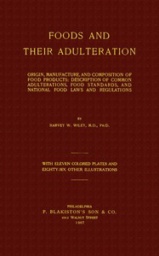

Foods and Their Adulteration (1907)
by Harvey Washington Wiley


The common codfish (family Gadidae) is the species Gadus callarias. It is rarely found south of the Virginia coast, but is especially abundant off the New England and Newfoundland coast. The great center of the codfish industry is in the vicinity of Newfoundland. Gloucester, Massachusetts, is the principal town devoted to the codfish industry in the United States. The cod is an omnivorous fish and especially fond of crustaceans, mollusks, and small fish. It also eats vegetation, and it is stated by Jordan and Evermann that all sorts of things have been found in cod stomachs, such as oil cans, finger rings, rubber dolls, rocks, pieces of clothing, etc. The livers of the cod, especially those of Norwegian origin, are extremely valuable, being the source of cod liver oil, which is considered by many to be the most valuable medicinal food known. Cod liver oil, while not palatable, is highly nutritious. The cod livers contain, according to some authorities, over 60 distinct chemical substances, many of which are highly important for their medicinal qualities. The cod move in schools, but not in such dense bodies as the mackerel, herring, and menhaden. Their movements are largely controlled by the temperature of the water and their desire for food. This species probably does not reach a greater length than 3 feet and a weight of more than 25 pounds. The average weight of the large-size cod in New England waters is about 15 pounds and on the Grand Banks of Newfoundland 20 pounds. The average weight of the small-size cod in these waters is about 12 pounds. It is one of the most prolific of fishes. The ovaries of a 21-pound cod were found to contain 2,700,000 eggs and of a 75-pound cod 9,100,000 eggs. The eggs are very small and require about 337,000 to make a quart. The cod is one of the most valuable of all fishes from a commercial point of view and also on account of international relations. On some occasions this country has apparently been on the verge of war with Great Britain respecting questions relating to the fisheries on the banks of Newfoundland. The U. S. Bureau of Fisheries has probably done more to propagate the cod than any other variety of fish. More than five hundred million cod fry have been liberated at different times by the Bureau and the number in one year has approximated 100,000,000. The color of the common cod is green or brown, but is subject to very great variations, - sometimes it is yellow or red and a variety of tints are assumed.🏁
Global Leaderboard
| # | Player | Time | Duration | Accuracy | WPM | pp | ||
|---|---|---|---|---|---|---|---|---|
| 1 | ||||||||
| 2 | ||||||||
| 3 | ||||||||
| 4 | ||||||||
| 5 | ||||||||
| 6 | ||||||||
| 7 | ||||||||
| 8 | ||||||||
| 9 | ||||||||
| 10 |


The common codfish (family Gadidae) is the species Gadus callarias. It is rarely found south of the Virginia coast, but is especially abundant off the New England and Newfoundland coast. The great center of the codfish industry is in the vicinity of Newfoundland. Gloucester, Massachusetts, is the principal town devoted to the codfish industry in the United States. The cod is an omnivorous fish and especially fond of crustaceans, mollusks, and small fish. It also eats vegetation, and it is stated by Jordan and Evermann that all sorts of things have been found in cod stomachs, such as oil cans, finger rings, rubber dolls, rocks, pieces of clothing, etc. The livers of the cod, especially those of Norwegian origin, are extremely valuable, being the source of cod liver oil, which is considered by many to be the most valuable medicinal food known. Cod liver oil, while not palatable, is highly nutritious. The cod livers contain, according to some authorities, over 60 distinct chemical substances, many of which are highly important for their medicinal qualities. The cod move in schools, but not in such dense bodies as the mackerel, herring, and menhaden. Their movements are largely controlled by the temperature of the water and their desire for food. This species probably does not reach a greater length than 3 feet and a weight of more than 25 pounds. The average weight of the large-size cod in New England waters is about 15 pounds and on the Grand Banks of Newfoundland 20 pounds. The average weight of the small-size cod in these waters is about 12 pounds. It is one of the most prolific of fishes. The ovaries of a 21-pound cod were found to contain 2,700,000 eggs and of a 75-pound cod 9,100,000 eggs. The eggs are very small and require about 337,000 to make a quart. The cod is one of the most valuable of all fishes from a commercial point of view and also on account of international relations. On some occasions this country has apparently been on the verge of war with Great Britain respecting questions relating to the fisheries on the banks of Newfoundland. The U. S. Bureau of Fisheries has probably done more to propagate the cod than any other variety of fish. More than five hundred million cod fry have been liberated at different times by the Bureau and the number in one year has approximated 100,000,000. The color of the common cod is green or brown, but is subject to very great variations, - sometimes it is yellow or red and a variety of tints are assumed.🏁
